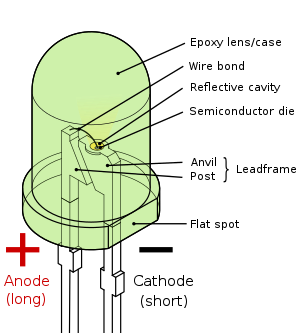LEDs are semiconductor light sources. They are usually used as indicators in devices, but now they are increasingly used for lighting. They were introduced in 1962 and have been further developed since then. Early LEDs were dim and did not last as long as they do these days.
When a LED is switched on, electrons recombine with holes within the device, releasing energy in the form of protons, which release light energy. A LED is usually small in size. They have many advantages over normal light sources, such as lower energy consumption, a smaller size, faster switching and a greater durability than light bulbs.
Light-emitting diodes are used in applications as diverse as replacements for aviation lighting and in traffic signals. The compact size of LEDs has allowed new text and video displays and sensors to be developed, while their high switching rates are useful in advanced communications technology. Infrared LEDs are also used in the remote control units of many commercial products including televisions, DVD players, and other domestic appliances.
Yeah, now I like playing with my LEDs. (Anyone have more?)

No comments:
Post a Comment